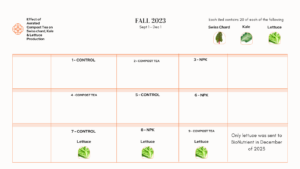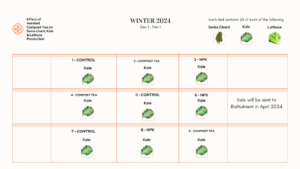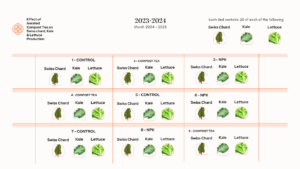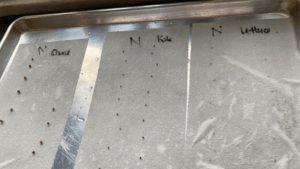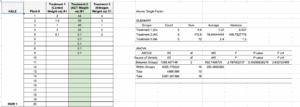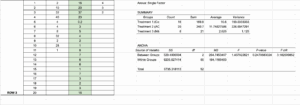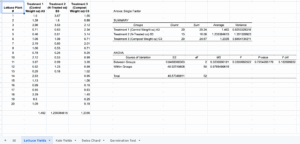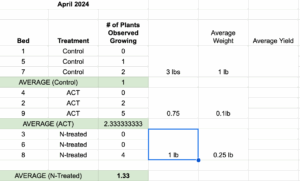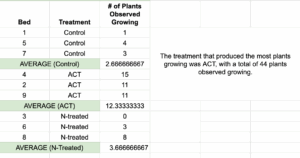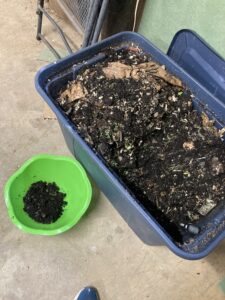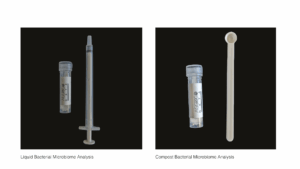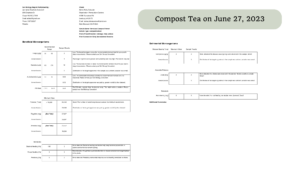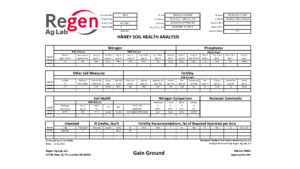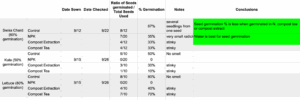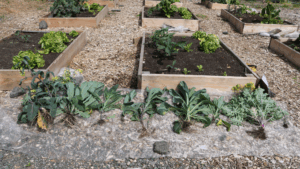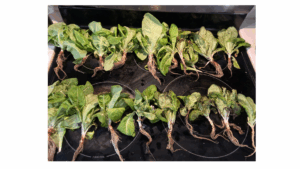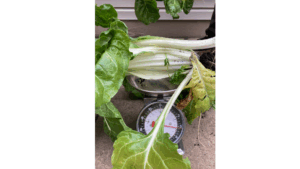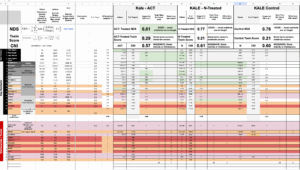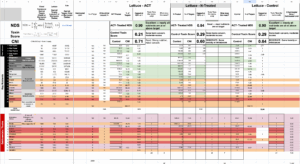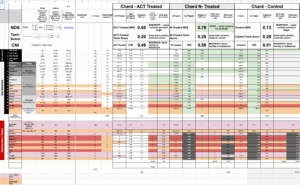Final report for FS23-353
Project Information
Abstract
Solutions to the problem of high-cost, unsafe, and non-sustainable commercial agricultural fertilizers will involve finding soil fertility methodologies that are:
- Effective: As effective as their commercial counterparts (if not more so)
- Low-cost: Solutions with minimal or preferably a one-time investment that is not reliant on industrial systems
- Sustainable: Solutions used to increase soil fertility and crop yield incrementally over time with repeated usage. A solution that "builds soil" with residual effects that are beneficial and not harmful to the environment.
A possible solution to the problem of commercial fertilizers could be using Aerated Compost Tea (ACT) during the growing phase of crops.
What this Study Does
This study observes and measures the effects of ACT on the:
- Germination
- Growth
- Weight
- Yield
- Nutrient Density (measured in NDS / Nutrient Density Score developed during the course of this research)
Of Swiss Chard (Beta vulgaris L. var. cicla),
Lettuce (Lactuca sativa), and
Kale (Brassica oleracea var. sabellica)
in a 3-month growing season.
What is Aerated Compost Tea (ACT)?
Aerated compost tea, or ACT is the cultivation of the diversity and biomass of beneficial aerobic microorganisms in the soil through the suspension of compost in an aerated water solution, which includes trace amounts of bacterial food in the form of molasses and fish emulsion (Morgan, 2017).
The finished solution is applied to the crop's soil as a root drench and sprayed on the leaves of the plant
What are the Benefits of Aerated Compost Tea if Proven a Viable Solution?
If ACT is proven to be viable, its benefits would be the following:
- Lowered Costs for External Inputs in the Current System of Farming
Current costs for farmer fertilizer inputs have risen dramatically.
"Several phosphate and potash fertilizer products have increased by 15-20 percent since late September, while the cost of anhydrous ammonia, urea, and other nitrogen fertilizer products have increased by approximately 50 percent in the past two months. The rapid increase in fertilizer costs is being driven by high global demand, very tight supplies of many fertilizer ingredients, and by shipping issues at U.S. ports." (Thiesse, 2022).
Unlike expensive chemical fertilizers, ACT requires no huge expense apart from the purchase of the following one-time equipment:
- A 5-gallon bucket
- A 200-watt pump and hose
- A mesh from which to suspend compost
- vermicomposting worms for the creation of bacterially-rich compost or a plant-based thermophilic compost
Thus, ACT is not industry-dependent since the farmer can create compost tea on the farm from his or her production waste.
Neither does ACT require a lot of input in time. The ACT process can take as little as 10 minutes to set up, as long as a source of compost is readily available.
In this study, pathogen-free vermicompost serves as the main source of compost. This compost is created in situ and does not require external purchase or inputs aside from the optional purchase of red-wriggler composting worms (Eisenia foetida).
- Similar or Improved Soil and Crop Fertility
ACT has been used as a crop fertilizer, soil amendment, disease suppressant, and foliar spray (Shaban & Fazeli-Nasab, 2015). It could play a threefold agricultural role in food production and negate the need for additional soil amendment or foliar spray products.
It introduces higher concentrations of microbial populations into the soil to increase their diversity and number. An increase in beneficial microbial life in the soil correlates with an increase in soil fertility (Ingham, 2005).
This microbial life, in turn, increases water retention and improves soil tilth or structure.
The liquid nature of compost tea allows it to seep into the soil and "harder-to-reach" areas without much effort from the farmer.
If proven viable, ACT could lead to similar or better crop fertility, growth, and yield. This would mean better production without costly inputs and chemical detriments to the environment and human health.
- Increased Nutrient-Density in Crop Production
If proven viable, another benefit of using ACT in crop production would be an increase in the nutrient density of the crops we grow.
Nutrient density in plants in this study is measured by comparing 21 key nutrients needed for optimal plant health. Because the data also provided certain heavy metal toxins found in plant leaf analysis, toxins were also taken into account and lowered the NDS score when present.
What are the Benefits of Studying the Effects of ACT on Swiss Chard, Kale, and Lettuce?
In this study, Swiss chard (Beta vulgaris L. var. cicla), kale (Brassica oleracea var. sabellica), & lettuce (Lactuca sativa) were chosen as crops due to their longer growing season in Virginia.
As such, they provide a more extended harvest season and longer-term potential income for the farmer throughout the year.
Another reason to study compost tea in the growth of these vegetables is that there are not many studies on the effects of compost tea on foliation. Instead, most studies deal with disease suppression. It would be good for farmers to understand the specific uses compost tea applications hold for different vegetables and at different seasons of the year. This study on leafy greens sheds light on one type of vegetable that is underrepresented in the literature.
Proposed Solution
I propose a study measuring the growth, yield, and nutrient density of Swiss Chard (Beta vulgaris L. var. cicla), kale (Brassica oleracea var. sabellica), & lettuce (Lactuca sativa) grown with and without ACT to discover whether or not ACT could outperform or match the results found by the use of commercial fertilizers.
The benefits of such a solution would be:
- Lowered Costs for External Inputs in the Current System of Farming
- Similar or Improved Soil and Crop Fertility
- Increased Nutrient Density in Crop Production
Conclusion
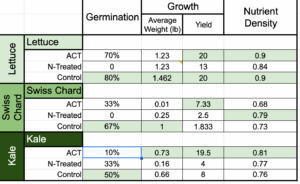
The results from the study revealed distinct outcomes across the three crops studied and general outcomes such as:
General Outcomes
- ACT benefits specific crops. While this study allowed for limited crop testing, the testing performed showed that ACT could be more beneficial when used on certain crops, and not necessary on others.
- The study also revealed that contrary to previous literature and teachings on aerated compost tea, compost tea microbiome diversity dropped significantly after six hours of brewing. Microbiome bacterial counts however did multiply for about three main bacterial families, suggesting that the aerated composting process selects for specific bacterial families and amplifies only a few families. This is in contrast to previously held teachings and beliefs that compost tea aeration amplifies all beneficial bacteria counts.
Distinct Outcomes
LETTUCE
ACT-treated lettuce, as well as Control, displayed the highest Nutrient Density Score (NDS) among treatments. ACT-treated lettuce also had the lowest toxin scores when compared to the other treatments, suggesting ACT could be a potential nutrient-enhancing treatment as well as a toxin-lowering treatment
SWISS CHARD
However, in Swiss chard, N-treated samples demonstrated the highest Nutrient Density Index (NDI)
KALE
In kale, the ACT treatment achieved the highest yield, Nutrient-Density Index (NDI), as well as the biggest root development.
Conclusions about ACT’s Effects on Leafy Greens (Swiss chard, Lettuce and Kale)
In this study, ACT made kale more nutrient-dense. In lettuce ACT affected nutrient density just as much as the control did.
ACT also seemed to increase the yield or number of plants harvested in Swiss chard and kale
ACT treatment was not helpful for seed germination.
ACT also did not help Swiss chard in terms of growth and nutrient density as the N-treatment did, which may suggest the benefits of ACT are crop-specific.
- Does ACT exhibit Similar or Improved Soil and Crop Fertility?
In this study, ACT treatments exhibited similar and improved soil and crop fertility for lettuce and kale but not for Swiss chard - Does ACT increase Nutrient-Density in Crop Production?
In this study, ACT treatments showed comparable nutrient density in lettuce and kale to their commercial counterparts but not in the case of Swiss chard - Does ACT have lower costs for external Inputs in the Current System of Farming
Yes! In this study, ACT costs include a one-time investment in a pump, bucket, and red wriggler worms, equivalent to ⅓ the cost of the Nitrogen application throughout the course of this project.
It is important to note that the number of treatments to measure nutrient-density in this study does not make the results statistically significant and further research and funding is encouraged as nutrient-testing is costly.
Compost Tea Microbiome Findings
This study primarily aimed to assess the impact of Aerated Compost Tea (ACT) on plant growth and soil health. While achieving these objectives, an unexpected yet significant observation was made. The research revealed that the brewing process of ACT led to a notable decrease in microbial diversity, as indicated by the Shannon Diversity Index and the Krona Graphs, when compared to the original vermicompost.
However, this reduction in diversity was accompanied by the selective amplification of specific beneficial microbial groups, including potential Plant Growth-Promoting Rhizobacteria (PGPRs) such as Pseudomonas and Acinetobacter. These organisms are known for their roles in nutrient solubilization, phytohormone production, and disease suppression.
This dual outcome presents a nuanced perspective: while lower microbial diversity might reduce ecological resilience, the targeted increase in PGPR populations could enhance ACT's functional benefits for disease control or plant growth. This finding was not anticipated in the original research design but opens a promising avenue for future studies. Further investigation is needed to determine optimal brewing practices that maintain microbial diversity while promoting the growth of beneficial bacterial communities, thereby maximizing the agronomic potential of ACT as a sustainable alternative to conventional fertilizers.
The microbial outcomes in vermitea vs. vermicompost, mirrors patterns seen in other tests run by the Aggrego Data lab of Dr. Zack Jones (Aggrego Data) as well as other vermimposters who have DNA tested their vermicomposts and vermiteas. These systems also show a shift from microbial diversity to functional dominance, of a few key bacterial players, which offer disease resistance and nutrient cycling benefits.
Together, these findings support the broader conclusion: when carefully brewed, Vermitea can be an effective, low-cost, and sustainable biofertilizer alternative, providing the same amount of beneficial bacteria when compared to commercial offerings, competitive plant health and nutritional benefits while reducing reliance on industrial inputs.
Research Question and Objective
In this study, I measured the effects of weekly and bi-monthly applications of Aerated Compost Tea (ACT) soil and foliar application on the production yield of Swiss chard (Beta vulgaris L. var. cicla), kale (Brassica oleracea var. sabellica), & lettuce (Lactuca sativa)
Research Hypothesis
I hypothesized that a weekly application of ACT to Swiss chard, kale, and lettuce in the warmer months and bi-monthly application of ACT in the cooler months would result in the same or improved yields as those to which commercial fertilizers (Nitrogen) are applied.
A secondary hypothesis was that this same application of ACT will result in greater nutrient density in Swiss chard, kale, and lettuce compared to those to which commercial fertilizers (NPK) are applied.
Cooperators
- - Producer (Educator and Researcher)
- - Producer
- - Technical Advisor (Educator and Researcher)
- - Technical Advisor (Researcher)
Research
1. Materials and Methods
a. Location and Choice and Map Plotting
The location I chose is the space below to be used for (9) nine 6 x 4 beds in our production garden on our farm, Bethany Farms, 41558 Stumptown Rd., Leesburg, VA 20176.
- Each bed was planted with 20 seeds of Swiss chard, lettuce, and kale. Each crop is numbered one to twenty.
Fall 2023 (Sept 1 - Dec 1)
Winter 2023-2024 (January 13 - March 1)
March 2024 - March 2025
ACT Beds planted with all 3 leafy greens
b. Project Implementation
This grant started on April 1, 2023. Swiss chard, kale, and lettuce were grown starting in October after research beds were built and compost and compost tea were tested in labs.
The first harvest of lettuce was on December 1st, 2023, and was sent to BioNutrient for analysis.
The total harvest, measurement, and weight of the first batch of lettuce planted in October 2023 was on March 1st, 2024.
The harvest of Swiss chard was sent to Apical Ag (an affiliate of BioNutrient) in October 2024.
Due to Bionutrient lab operational difficulties, kale has yet to be sent to the lab for assessment.
Brewing the Aerated Compost Tea
Aerated Compost Tea (ACT) was brewed using the guidelines outlined in this SARE Document, "Aerated Compost Tea: A Field Guide to Production Methods, Formulas, and Application Protocols," keeping in mind the need to create a pathogen-free ACT with every application. This manual emphasizes that the compost from which ACT is made cannot contain animal products and must be free of four types of pathogens:
- Salmonella
- E.coli
- Listeria monocytogenes
- Fecal coliforms
This SARE document also recommended labs that can test compost for the presence of these pathogens before making compost tea from them.
As part of this study, a sample of finished vermicompost and thermophilic compost was sent to a Soil Food Web lab called Brightside Acres before brewing ACT. This helped ensure the pathogen-free nature of the ACT used in the test.
Preparation for Crop Testing
-
Creation of Viable ACT
After I determined that the vermicompost I was going to use was pathogen-free, ACT was brewed from a quart-size sample of the compost. Previous studies on ACT have shown that diversity in compost types produces more effective compost teas (Kim et al., 2015). But this study only uses vermicompost as the compost base. ACT was applied to the soil-growing media of Swiss chard, kale, and lettuce seeds sown in May 2023 (See timeline in this document) and every week post-germination until it was transplanted in-ground in October 2023.
-
Soil Testing to determine N-application requirements
Using the Southeastern Vegetable Crop Handbook, and soil test results, the amount of the recommended Nitrogen application for leafy greens was determined. This application was 1/4 teaspoon of this commercial Nitrogen product per 5 gallons. This was the amount of N application used for the N-treated research beds.
-
Building the Raised Beds
Nine 6 x 4 research beds in a sunny area were built on our property dedicated for this research.
-
ACT Application
After brewing for 12 hours, ACT was applied as a root drench and foliar spray (if leaves were present) once a week from transplant through September and once every other week during the Virginia cool season (October through March).
Growing & Testing Phases
Crop Trial 1: Fall 2023 (Oct 31 - Dec 8)
Crop Trial 2: Winter 2023-2024 (January 13 - March 1)
Crop Trial 3: Spring 2024 (April 1- July 24)
Data Analysis, Study, and Outreach Phase
Winter 2024-2025 (November 13 - March 31)
I presented my preliminary findings at the VA Biological Farming Conference on January 11, 2025.
Observation and Data Recording
Before harvest, I did my best to note observations of the above-ground growth of Swiss chard, kale, and lettuce. These observations included, but are not limited to:
- Checking for the presence of
- Weeds
- Pests
- Disease
- Measuring the "diameter crown" width of cabbage, kale, and lettuce
Records on this Google Sheets document.
Photos in this Google Drive Folder.
Movies in this Google Drive Folder.
Documents in this Google Drive Folder.
c. Experimental Design and Data Analysis
After consultation with Shawn Jadrinicek, a practicing permaculturist, author, and Virginia Tech extension agent, I decided to implement his suggestion of conducting the trail with 3 treatments in 9 beds.
Treatments:
- Treatment 1: Control - Untreated raised bed of 20 Swiss chard, 20 kale plants, and 20 lettuce plants
- Treatment 2: Nitrogen-Treated crops - a raised bed of 20 Swiss chard, 20 kale plants, and 20 lettuce plants that are treated with RAW Nitrogen (1 cup per 25-foot row / monthly)
- Treatment 3: ACT-Treated crops - a raised bed of 20 Swiss chard, 20 kale plants, and 20 lettuce plants treated with ACT every week.
Variables: Crop Yield, Crown Diameter, Nutrient Density
d. Data Collection & Measurement
Germination Comparison
Germination tests were conducted using 20 of each leafy green crop: kale, lettuce, and Swiss chard seeds across three treatments: Control (compost only), ACT (aerated compost tea), and Nitrogen-treated.
Seeds were sown on paper towels. Germination was tracked by counting the number of visibly sprouted plants per treatment after planting.
Growth Comparison Methodology
Average plant weights were estimated by harvesting and weighing individual plants per bed at maturity. For kale and lettuce, weight data was collected per plant. The number of viable plants per bed was used to calculate final plant yield.
A single-factor ANOVA test was used for Swiss chard and kale using XLMiner Analysis Toolpak on data stored in Google Sheets to measure growth in terms of harvested crop weight (in pounds) and yields at:
- 100 days for Swiss Chard
- 60 days for kale
- 31 days for lettuce
For Swiss chard, only average weight per bed data was available as harvesting was done irregularly and by different people.
Nutrient Density Testing Protocol
A representative sample of each treatment group was submitted for nutrient density testing. Scoring was based on nutrient-rich metabolite content (e.g., polyphenols, minerals, antioxidants). A normalized scale (0.0 to 1.0) was used to compare across treatments and crops.
During the course of the research, a Nutrient Density Score (NDS) was developed in collaboration with data from Apical Ag, a Bionutrient Institute research partner.
This number represented the nutrient density of the sampled crop.
To balance nutrient density with food safety, a Clean Nutrient Index (CNI) was also developed:
CNI = NDS (1-Toxin Score)
The Toxin Score penalizes the presence of harmful compounds such as nitrates, ammonium, and heavy metals. Each toxin is weighted by severity (Tier 1 = mild, Tier 2 = moderate, Tier 3 = high):
Microbiome Analysis Methods
Vermicompost and vermitea from ACT treatments were submitted for microbial DNA analysis (via Aggrego Labs). Microbial populations were identified to evaluate potential correlations between compost biology and crop outcomes.
Microscopy
Vermicompost and vermitea from ACT treatments and control were submitted for microscopic analysis (via Brightside Acres Labs) twice during the course of the research.
Sampling Method Sampling of vermicompost was done by using test tubes and spoons provided by Aggrego Data Lab and mixing vermicompost from an active bin into the solution in the provided test tubes.
Sampling of ACT was taken from a 5-gallon bucket of vermicompost suspension. A tablespoon each of fish hydrolysate and humic acid was added and then the 5-gallon bucket was brewed for 12 hours.
Results and discussion
Lab Analysis of Inputs
Before growing any leafy greens, I began by testing the quality of my soil, vermicompost, and a batch of aerated compost tea (ACT) brewed from the vermicompost bin. I submitted samples to two different labs for analysis:
- Brightside Acres Lab (North Carolina) – a microscopy-based lab run by Steven Disla
- Aggrego Data DNA Testing Lab (Colorado) – for advanced microbial DNA analysis by Dr. Zack Jones
Brightside Acres Lab Findings (June 27, 2023)
- Vermicompost: Lower than recommended levels of beneficial bacteria; no pathogenic bacteria detected.
- Vermicompost Tea: Beneficial bacteria largely absent; no pathogens detected.
Results_2023-06-27_Nicky_Schauder_Vermicompost
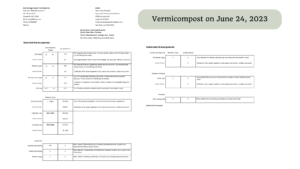
Results_2023-06-27_Nicky_Schauder_Vermicompost_Extract
-
Vermicompost Tea:
-
Beneficial bacteria were largely absent.
-
No pathogens were detected.
-
When I asked the lab technician about the low bacterial count in the ACT, he explained that the microbes had likely died off because I had not fed them during brewing. Even though the tea was aerated, microbes still need a food source to survive and proliferate.
Discussion: Organic Standards
These findings raise questions about the current National Organic Standards, which prohibit feeding microbes during compost tea brewing. Based on this experience, I believe a more nuanced standard should be developed:
-
Compost tea should not be brewed from large or medium animal manure.
-
But it should be permissible to brew tea from vermicomposting worms, particularly Eisenia fetida and Eisenia andrei, as studies show their gut processes reduce pathogens significantly.
Two studies supporting this view include:
-
Procházková et al. (2018): Demonstrated that Eisenia andrei can reduce pathogen levels during vermicomposting.
-
Eastman et al. (2001): Investigated the use of vermiculture to reduce human pathogens in biosolid stabilization under EPA guidelines, showing promising results for sustainable waste management.
Soil Test and Nitrogen Application
To determine the appropriate nutrient supplementation for the commercial treatment group:
- A soil test was conducted.
-
Based on the Southeastern Vegetable Crop Handbook, nitrogen was the only nutrient that needed supplementation.
-
Product: RAW Nitrogen (20% ammoniacal N from ammonium sulfate)
Year 1 Application:
-
½ teaspoon per 5-gallon batch per bed
Year 2 Calculation (based on 72 sq ft across 3 beds):
-
Target: 0.0017–0.0034 lbs N/sq ft = 0.124–0.248 lbs N
-
Required RAW Nitrogen: 0.62–1.24 lbs (9.9–19.8 oz)
-
Applied: 1.25 cups per 5-gallon batch
Grow Comparison Summary
Kale
-
ACT-treated: Highest average weight (11.7 oz) but high variance (499.8)
-
Control: 10.6 oz
-
Nitrogen-treated: 2.6 oz
-
ANOVA p-value: 0.247 (no statistically significant difference)
Lettuce
-
Control: 1.462 oz (highest mean)
-
ACT: ~1.23 oz
-
Nitrogen-treated: ~1.23 oz
Swiss Chard
-
Control: 1.0 lb
-
ACT: 0.1 lb
-
Nitrogen-treated: 0.25 lb
While ACT increased viable plant count in Swiss chard, it had the lowest weight per plant, suggesting a need for thinning or nutrient optimization.
Germination, Growth and Nutrient Density Comparisons
Brix Readings for Swiss Chard (Oct 20, 2024)
| Treatment | 7:30AM | 3:30 PM | |
| Control | 4 | 6 | |
| N-Applied | 5 | 10 | |
| Compost Tea | 6 | 10 |
-
Compost tea matched nitrogen-treated Brix readings by afternoon.
-
Suggests ACT may enhance sugar/nutrient content. Further research is suggested
Nutrient-Density Scores (NDS) by Crop & Treatment
Kale:
Lettuce:
Swiss Chard:
-
While toxin levels were consistently concerning across treatments, they did not vary significantly, so the NDS was used as the primary scoring metric, not the CNI.
Germination, Growth and Nutrient-Density Scores (NDS) by Crop & Treatment
-
ACT improved kale and lettuce nutrient density.
-
Nitrogen improved Swiss chard nutrient density.
Aggrego Data DNA Lab Test Results
- Compost was brewed in a 5-gallon bucket of well water for 12 hours with humic acid and seaweed extract (no molasses).
- Reports showed a significant drop in microbial diversity after brewing.
-
Microbiome Analysis
-
DNA sequencing of the ACT revealed dominance by Acinetobacter and Pseudomonas (both known PGPRs), with smaller contributions from Flavobacterium, Comamonas, and Azotobacter. Classic Bacillus and Actinobacteria were present only at trace levels, while Enterobacteriaceae (e.g., Klebsiella, Enterobacter) were detected at low but notable abundance (~2%)
-
DNA analysis shows a high diversity in vermicompost, but a low diversity of bacteria in vermicompost tea.
-
Beneficial vs. Opportunistic Species: While the presence of Bacillus and some Pseudomonas strains can aid plant growth, the decline in diversity may reduce resilience and function.
Below is a Krona graph of a sample of the vermicompost used in the study which shows bacterial diversity with each color indicating a particular bacterial family
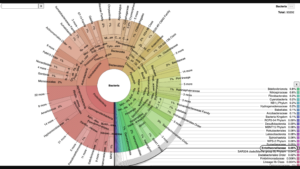
Vermicompost Population -
Reduced diversity post-brewing
Below is the Krona graph of a sample of compost tea made from the vermicompost and brewed for 12 hours. It shows significant diminishes bacterial diversity using the Shannon Diversity Index
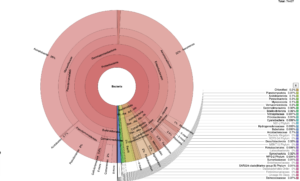
Compost Tea shows diminished bacterial diversity -
Bacillus spp. correlated with high NDS in kale
-
Swiss chard showed no such correlation
This suggests crop-specific microbial responses. Increased microbial presence alone does not guarantee improved nutrition or yield across all crops.
Overall Takeaways
-
Lettuce: ACT improved nutrient density (NDS & Brix) but not root development.
-
Kale: ACT boosted nutrient content and resilience.
-
Swiss Chard: No yield benefit; nitrogen improved NDS.
-
Sustainability: ACT is a viable organic alternative for some crops.
-
Microbial Selectivity: Rather than increase populations of bacteria and maintain overall diversity, ACT selects for a few microbes.
-
Implication for Use:
-
The tea may still provide plant-growth–promoting effects, but it is less ecologically balanced than the starting vermicompost.
-
Monitoring is important, since a narrow community can sometimes lead to instability or favor less desirable organisms.
-
Further trials should control for environmental factors and refine ACT brewing to maintain broader microbial diversity.
-
-
-
The next questions from this phenomenon would be:
"What do these specific bacteria that we end up with in the ACT do for the plants and why would they be helpful for plant growth or health?" or "Why do we brew compost tea and select for these particular microbes?
"What specific ACT feeds promote what kinds of bacteria in ACT?
Educational & Outreach Activities
Participation summary:
Outreach is the heart of the work that I do on my farm. Each growing act, for me, is an act of service and outreach. The food that I grow and sell is an outreach.
I teach how to grow food online monthly in a live workshop, sometimes daily through social media, and weekly through my gardening newsletter. This is how I currently teach families how to grow their own food and medicine and find God through ecological gardening.
Since 2017, I have started permaculture school gardens in Title 1 schools at the elementary and middle school level, and I continue volunteering after-school to teach gardening to middle school children in Sterling, VA, on Tuesdays.
Throughout the course of this research, I was honored to be able to share my ongoing findings about compost tea on our online webinars and at the following venues
Mother Earth News Conferences:
February 18-19, 2023 - Belton, Texas
April 29-30, 2023 - Lawrence, Kansas
July 15-16, 2023 - Erie, Pennsylvania
Sept. 16-17, 2023 - West Bend, Wisconsin
Mother Earth News Online Conference
January 2025 - I presented "Compost Tea for the Organic Grower" at the VA Biological Farming Conference.
Sept 24, 2025 - I presented "Compost Tea for Organic Growers" on an online webinar
I have spoken about my Compost Tea research on podcasts such as:
GardeNerd
Lady Farmer's the Good Dirt Podcast
I also look forward to continue to presenting the findings of this project at local farming conferences, farming outreaches in Southern regions, and online.
Learning Outcomes
Knowledge about the safe preparation of Compost Tea
Knowledge about the appropriate use of compost tea
Knowledge about the kinds of compost tea
Knowlege about the benefits of compost tea
Project Outcomes
The project focusing on the use of Aerated Compost Tea (ACT) represents a significant stride towards enhancing agricultural sustainability. By investigating the effectiveness of ACT in improving soil fertility and crop yield, this research aligns with the broader goals of sustainable agriculture, which aims to be economically viable, environmentally friendly, and socially responsible. Here's an assessment of how the project affects agricultural sustainability or will contribute to future sustainability:
Economic Benefits
- Cost Reduction: The use of ACT offers a notable reduction in the cost of fertilizers for farmers. Given the sharp rise in commercial fertilizer prices, ACT provides a cost-effective alternative that relies on on-farm inputs rather than purchased chemical fertilizers. The initial investment in equipment for ACT production is relatively low and is a one-time cost, which could significantly lower the operational costs of farming in the long term.
- Increased Profitability: By potentially improving yield and crop quality through enhanced nutrient density, ACT could lead to higher market values for the produce and increased profitability for farmers. Additionally, the reduced cost of inputs directly translates to better financial margins.
- Resilience to Price Fluctuations: By decreasing dependence on commercial fertilizers, farmers can become more resilient to market volatility and the fluctuating prices of chemical inputs, leading to more stable economic conditions for their farming operations.
Environmental Benefits
- Soil Health Improvement: ACT enriches the soil with beneficial microbes, improving soil structure, enhancing nutrient cycling, and increasing water retention. This contributes to the long-term fertility of the soil, ensuring sustainable crop production.
- Reduction in Chemical Use: The project promotes a reduction in the use of synthetic fertilizers and pesticides, minimizing soil and water pollution. This shift contributes to the preservation of ecosystems and biodiversity within agricultural landscapes.
- Climate Change Mitigation: By enhancing soil organic matter through the application of ACT, the project contributes to carbon sequestration, helping mitigate climate change. Additionally, reducing the dependency on chemical fertilizers decreases the carbon footprint associated with their production and transportation.
Social Benefits
- Health and Safety: Reducing chemical use in agriculture diminishes farmers' and consumers' exposure to potentially harmful substances, contributing to overall public health. The production of more nutrient-dense food through ACT can also support better nutrition for communities.
- Knowledge and Skill Development: This project fosters a deeper understanding of sustainable farming practices among farmers, enhancing their skills in producing and applying ACT. It encourages knowledge-sharing within the farming community, promoting a collective move towards more sustainable agricultural practices.
- Community and Consumer Trust: By adopting environmentally friendly practices like ACT, farmers can strengthen trust with consumers who are increasingly concerned about sustainable and responsible farming methods. This can enhance community support for local agriculture and encourage a shift towards consuming locally produced, sustainable food.
Contribution to Future Sustainability
The project lays the groundwork for future research and adoption of sustainable practices in agriculture by providing empirical evidence of ACT's benefits. It serves as a model for integrating low-cost, effective, and environmentally sustainable practices into farming, encouraging wider adoption and adaptation. The findings could influence policy, encourage support for sustainable farming initiatives, and drive innovation in sustainable agriculture technologies and methodologies.
In summary, the project's focus on Aerated Compost Tea (ACT) presents a comprehensive approach to agricultural sustainability, addressing economic viability, environmental health, and social well-being. Its success could herald a significant shift towards more sustainable, resilient, and productive farming systems.
Recommendations for Future Study & Comments for SARE
This farmer-led research revealed promising trends suggesting that Aerated Compost Tea (ACT) may enhance nutrient density and plant resilience—particularly in kale and lettuce—while also showing variability in crop response (e.g., limited yield benefit in Swiss chard). However, due to limited sample sizes, these trends were not statistically significant, and further research is needed to confirm these observations under controlled conditions.
We recommend future studies supported by SARE that focus on:
-
Replicated trials with larger sample sizes across multiple farms and regions to increase statistical power and generalizability.
-
Standardized ACT brewing protocols to better compare results and identify which inputs (kelp, molasses, etc.) yield the best outcomes. This is furthered explored in this SARE study .
-
Longer timeframe for soil microbiome analysis to track microbial changes over time and correlate specific communities with crop performance. In the second study, I only had funds to track two different times of compost tea microbial harvesting.
-
Crop-specific studies to better understand how different annual and perennial crops in general, not just leafy greens respond to ACT in terms of yield, root development, and nutrient density.
-
Economic analysis of ACT adoption, including labor, equipment cost, and return on investment.
I also encourage continued support for farmer-researcher partnerships, as this format has allowed us to directly integrate sustainable practices into real-world growing systems, improve our understanding of living soils, and foster a culture of inquiry and innovation at the farm level. I am grateful to have consulted with extension agents, Shawn Jadrinicek, Beth Sastre, Dr Zack Jones and Steven Disla Dr. David Knaus and Justine Roney and my husband David throughout the course of this two-year study.
Moreover, gratitude and appreciation goes out to Candace Pollock, Marian Dalke and Denise Beeland-Quick at SARE’s for their encouragement, guidance and administrative work to make this project possible. I truly believe the ability to test and iterate on biologically based, low-input solutions like compost and its derivatives is key to helping small farms transition toward regenerative agriculture.
